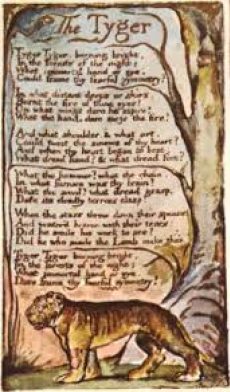
Email: ZYVC057@live.rhul.ac.uk
Total Article : 213
About Me:I'm a graduate student studying International Criminal Law and first started writing for King's News almost 4 years ago! My hobbies include reading, travelling and charity work. I cover many categories but my favourite articles to write are about mysteries of the ancient world, interesting places to visit, the Italian language and animals!

The Tyger
Tyger Tyger, burning bright,
In the forests of the night;
What immortal hand or eye,
Could frame thy fearful symmetry?
In what distant deeps or skies.
Burnt the fire of thine eyes?
On what wings dare he aspire?
What the hand, dare seize the fire?
And what shoulder, & what art,
Could twist the sinews of thy heart?
And when thy heart began to beat,
What dread hand? & what dread feet?
What the hammer? what the chain,
In what furnace was thy brain?
What the anvil? what dread grasp,
Dare its deadly terrors clasp!
When the stars threw down their spears
And water'd heaven with their tears:
Did he smile his work to see?
Did he who made the Lamb make thee?
Tyger Tyger burning bright,
In the forests of the night:
What immortal hand or eye,
Dare frame thy fearful symmetry?
Analysis:
‘The Tyger’ is perhaps William Blake’s most famous poem. It consists of six stanzas, each four lines long. The first and last stanza are identical, only the word ‘could’ is substituted with the word ‘dare’ in the last stanza.

‘The Tyger’ is a poem of questions. Indeed there are thirteen question marks throughout the poem and only a single sentence that does not end with a question mark but a full stop. The speaker addresses the ‘Tyger’ and questions its creation: ‘Who made you Mr. Tyger?’, ‘How were you made? Where? Why? What was the person or thing like that made you?’. What makes this poem unique is that it doesn’t follow any particular narrative movement as there are no actions taken apart from questioning the ‘Tyger’. IN the first stanza the speaker reveals his/her central question about why created the creature (‘What immortal hand or eye, / Could frame thy fearful symmetry?’). The second stanza inquires where the creature was created and the third is about questioning how the creator made him; the fourth stanza questions what tools the creator used and the fifth stanza asks what the creator’s reaction to the Tyger was and lastly, the sixth stanza reinstates the central question on who would dare create the Tyger. The Tyger is part of William Blake’s collection of ‘Songs Of Innocence and Experience’ and is usually thought to be a companion piece of ‘The Lamb’ in Songs of Innocence as both poems ask the same question about the creator. In the Lamb, an answer is given and it is God. In The Tyger the author leaves the answer open to interpretation, it implies an answer by stating ‘Did he who made the Lamb make thee?’ but never confirms this query. The poem’s meaning is open to interpretation: some think the poem is concerned with issues of mystical knowledge, the sublime, inspiration and poetry but ultimately each reader will see the poem through different lenses.
About the Author:
William Blake was a very famous British painter, poet and printmaker born in 1757 in Soho, London. To date he is considered to be one of the most prominent voice of the Romantic Age, a literary movement which emerged in the 18th Century. Blake’s vision of poetry was that common people could read and interpret it but he would not sacrifice his vision or his style in order to become more popular. Throughout his lifetime Blake produced some outstanding pieces of artwork which can be found at the Tate and Metropolitan Museum of Art amongst others.
Image 1: http://daily.stcuthberts.com/wp-content/uploads/2012/04/tiger-growl95895_small.jpg
Image 2: http://mrslux.pbworks.com/f/1245886744/theTyger.jpg

0 Comment:
Be the first one to comment on this article.